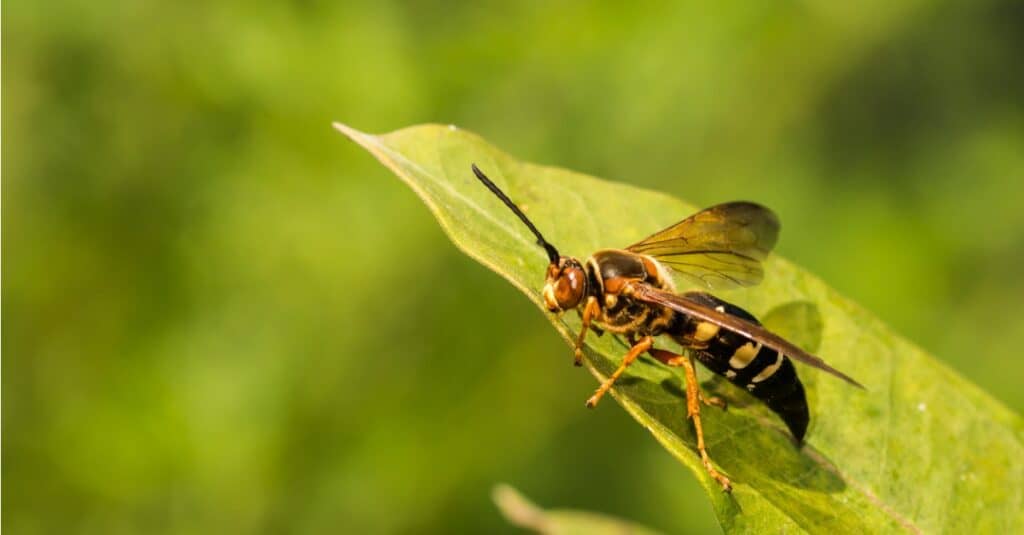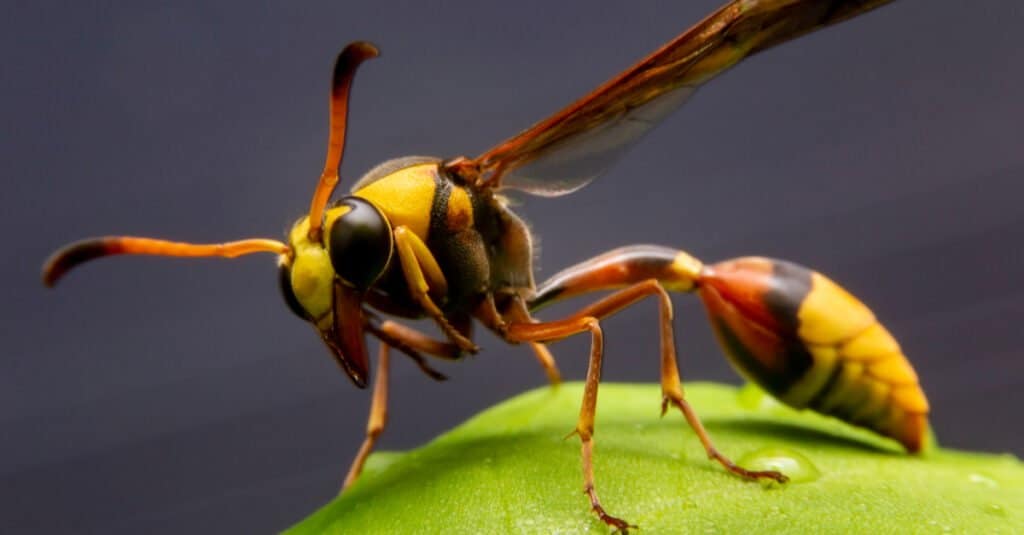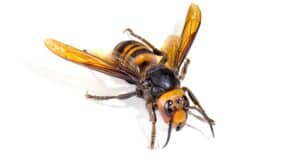Wasps vs. yellow jackets are small flying insects, which are widespread around the world. At first glance, wasps and yellow jackets look almost exactly the same, which can often lead to confusion. In fact, both insects are actually classified as wasps and belong to the same order(the Hymenoptera order). It isn’t helped by the fact that they even behave in very similar ways. So, how do we tell them apart? Well, to do that we need to understand the differences between Wasps and Yellow Jackets. So what are the differences?
Comparing Yellow Jacket vs. Wasp

Check out the chart below to learn a few of the main differences.
| Yellow Jacket | Wasp | |
| Size | 0.5 to 0.75 inches | 0.25 to 1 inch |
| Habitat | Meadows, orchards, woodland, urban areas | Gardens, hedgerows, meadows, woodlands |
| Color | Black and yellow | Black and yellow are common but can be red, orange, or black |
| Body | Small but stocky | Slender with a thin waist |
| Flight | Legs tucked underneath | Legs dangling |
| Behavior | Aggressive will attack unprovoked | Less likely to attack |
| Nest | Underground | Above ground |
| Predators | Birds, raccoons, skunks, moles, shrews, badgers | Birds, dragonflies, hornets, centipedes, spiders, praying mantis, beetles |
Wasp vs. Yellow Jacket: The Main Differences Between Them
Although yellow jackets and wasps do look pretty similar, there’s a difference in their color variation. While the former has a yellow and black appearance, the color of the other kind of wasps varies from red to orange or blue. Besides, they nest in different places, have different body shapes, and behave in very different ways.
Yellow jackets are predatory social wasps belonging to the Vespula and Dolichovespula genera. On the other hand, wasps in the Pepsis genus (the spider wasps) are typically solitary and non-aggressive wasps. Despite them being a type of wasp, there are still plenty of differences that set yellow jackets apart from all the other wasps around.
Now, let’s discuss in detail the key differences between yellow jackets and wasps.
Wasp vs. Yellow Jacket: Color

Wasps are often the same color as yellow jackets but have a less yellow tone than the latter.
©iStock.com/JasonOndreicka
When we think of wasps most people probably immediately think of the common, distinctive black and yellow appearance. Although this is true as many wasps do look exactly like that, there is actually a greater variation in their colors than we expect. This is because – depending on the species – wasps can be anything from orange or red to blackish blue color.
On the other hand, yellow jackets tend to stick to their noticeable yellow and black appearance. They also have dark wings and black antennas. But whenever other types of wasps are black and yellow the way to distinguish them from yellow jackets is that the former tend to be more black-toned while yellow jackets are more yellow-toned.
Wasp vs. Yellow Jacket: Body Shape
One of the main differences between wasps and yellow jackets is their body shape. Although it’s not recommended to get too close when looking at them, yellow jackets are smaller but stockier than wasps. Yellow jackets are generally between 0.5 and 0.75 inches long and have quite a thick-set body. However, wasps are longer and range up to 1 inch long, but are more slender and have a noticeably thinner waist.
Wasp vs. Yellow Jacket: Flight

While flying, yellow jackets tuck their legs underneath while wasps dangle their legs.
©Witsawat.S/Shutterstock.com
When we see wasps and yellow jackets flying there is a noticeable difference between their legs. This is because yellow jackets carry their legs tucked underneath them while they are flying. On the other hand, most wasps fly with their legs dangling below them.
Wasp vs. Yellow Jacket: Nest
One of the most noticeable differences between yellow jackets and wasps is the location of their nests. Wasps usually nest above ground on structures such as roofs, eaves, or beams. The appearance of the nest can vary depending on the species but usually has either a honeycomb appearance or looks like a large upside-down cone.
Yellow jackets are quite different and nest underground. Their nests are usually in protected places such as soil cavities, tree stumps, or burrows. Yellow jacket nests are often difficult to spot because of their location and they usually only have a single opening.
Wasp vs. Yellow Jacket: Behavior

Yellow jackets are more aggressive and much more likely to attack than wasps
©Ernie Cooper/Shutterstock.com
Quite possibly the biggest difference between wasps and yellow jackets is their behavior. Yellow jackets are extremely aggressive and will often sting even when unprovoked. If their nest is threatened then they can even attack as a swarm. Wasps, on the other hand, are far less likely to attack. They are generally quite docile and prefer to avoid us, humans. However, they will still attack if their nest is threatened.
FAQ’s (Frequently Asked Questions)
Are yellow jackets wasps?
Yes, just to make things confusing, yellow jackets are actually wasps. Wasps are typically described as being any insect from the order Hymenoptera and suborder Apocrita which are not bees or ants. Therefore, yellow jackets are wasps as they fulfill this criterion. The best-known wasps are yellow jackets and hornets.
Which genus are yellow jackets from?
Yellow jackets are from the Vespula and Dolichovespula genera. Vespula contains yellow jackets which are located across the Northern Hemisphere. Dolichovespula contains social wasps which are also located across the Northern Hemisphere. However, only the yellow and black members of this genus are known as yellow jackets.
Do wasps and yellow jackets eat the same things?
Yes, wasps and yellow jackets eat mostly the same things. They both eat a range of insects such as caterpillars, small flies, and grubs. They also eat nectar, tree sap, and fruit. However, particularly in urban settings, yellow jackets are also attracted to human food such as meat or sweets.
Are wasps and yellow jackets dangerous to humans?
Although it’s never a good idea to get too close to a wasp or a yellow jacket because they can attack and they do have the ability to sting, they are generally only seriously dangerous for people who are allergic or are stung many times.
How Long Will Yellow Jackets Chase You?

Yellowjackets are common in North America and are attracted to the sweet food you may leave out.
©Henrik Larsson/Shutterstock.com
It is possible, for most people, to outrun a yellow jacket but it won’t be a particularly quick or short getaway. Yellow jackets are known to pursue people for up to one mile and will follow you wherever you go, even if you try to run indoors. Even jumping in water can be tricky as they are known to hover above the surface, waiting for you to come out.
If you don’t wish to become the target of a yellow jacket, there are some things you can do to prevent being noticed. Some of these are:
- Eliminate food sources. These wasps are attracted to the scent of food, even more so if it’s sweet and sticky, and may even attempt to get at your sweet beverages. Make sure you keep food sealed or covered to keep them away.
- Ensure your garbage cans are sealed. Garbage cans are a haven for yellowjackets and wasps. They are drawn to the scent of rotting food and as long as you keep the lids tightly closed, you won’t have a surprise waiting for you on trash night.
- Remain far from their nests. Like most animals, if you enter their territory, yellowjackets will feel threatened and will defend their nests. If you see a nest on your property, it is always best to call a professional to handle it.
- Make sure your clothes aren’t brightly colored. Yellow jackets, wasps, and even bees are attracted to bright colors and if you are wearing these items, you may attract unwanted yellow jacket attention.
The photo featured at the top of this post is © Ernie Cooper/Shutterstock.com
Thank you for reading! Have some feedback for us? Contact the AZ Animals editorial team.







